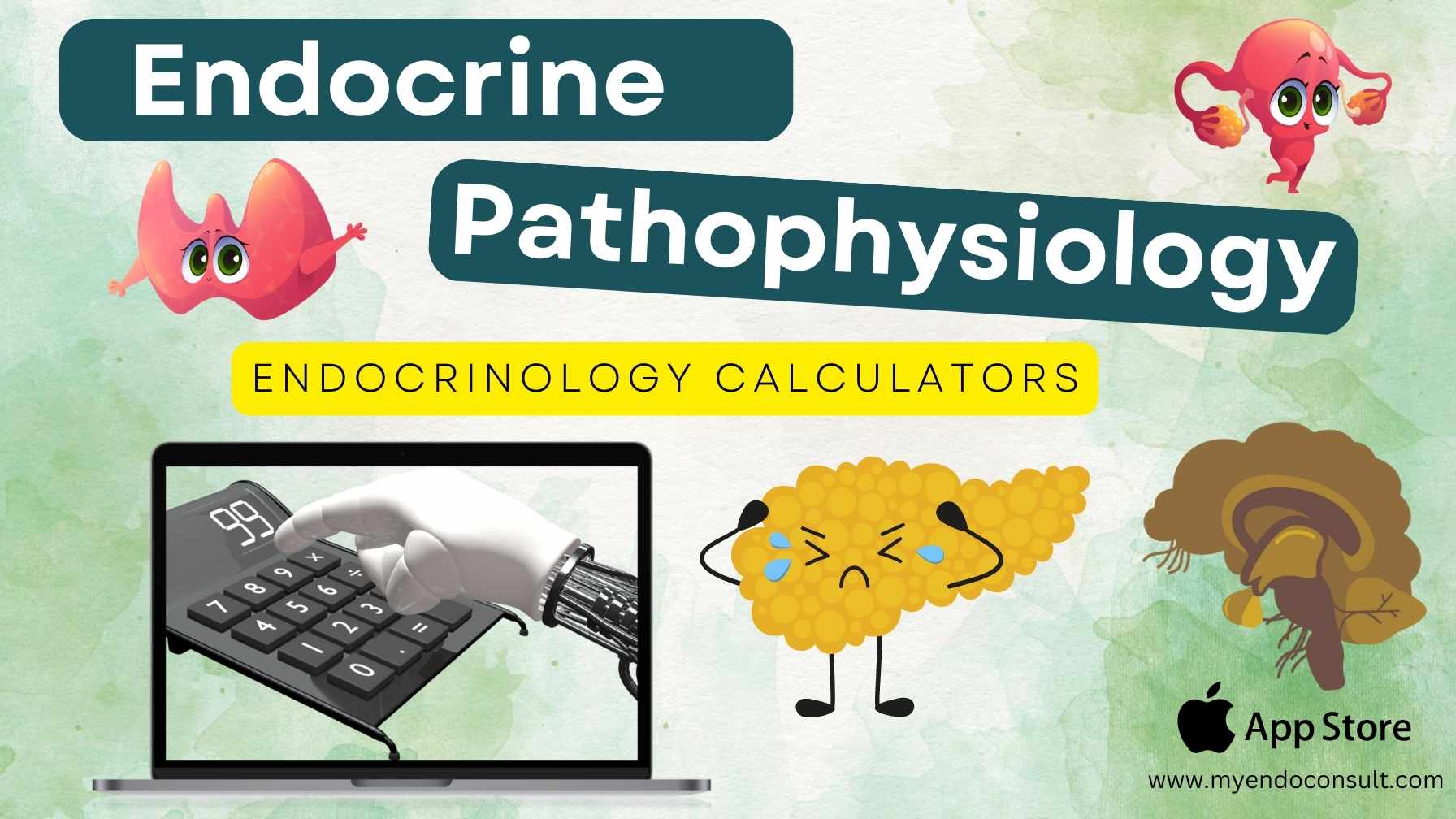
A thyroid storm refers to a life-threatening metabolic and multisystemic dysfunction characterized by a state of excess thyroid hormone (productive hyperthyroidism) and an inciting concurrent illness[1].
The Burch-Watorfsky Score is a clinical decision support tool for predicting the likelihood of thyroid storm in a patient with metabolic decompensation in the setting of biochemical evidence of overt hyperthyroidism. Patients at risk for this condition are likely to have other clinical features suggestive of underlying thyroid dysfunction, such as goiter, exophthalmos, etc. It is worth noting that apathetic hyperthyroidism may occur in elderly patients. It is a state of hyperthyroidism with minimal or no overt signs or symptoms even in the setting of an impending thyroid storm. Patient’s with this condition cannot be easily risk stratified based on the Burch-Wartofsky Score.
Calculator for the Burch-Wartofsky scale
This calculator estimates the total points on the Burch-Wartofsky scale and provides recommendations for treatment of thyroid storm based on the risk category.
Treatment of thyroid storm (impending or highly likely)
The treatment of thyroid storm involves the institution of interventions that address various points in the pathophysiology of this condition. Therapy may be aimed at thyroid hormone synthesis, secretion, or its peripheral action. Additional steps to reverse incipient systemic decompensation and treatment of all inciting events are complementary in the management of thyroid storm.
Inhibition of thyroid hormone synthesis
Thionamides block the synthesis of new thyroid hormones. Methimazole (MMI) or Propylthiouracil (PTU) can be administered via the oral, nasogastric, or rectal routes.
- PTU : A loading dose of 600-1000mg stat, followed by a total daily dose of 1200-1500mg administered as 200-250mg every 4 hours.
- MMI : A total daily dose of 120mg may be administered as 20mg every 4 hours.
Inhibition of thyroid hormone release
- Iodine preparations such as Lugol’s solution, ipodate or potassium iodide (SSKI)
- Lithium carbonate.
Blunting of the peripheral effects of thyroid hormone
- Glucocorticoids, propranolol, amiodarone, iopanoic acid, and PTU inhibit deiodinase enzymes involved in the conversion of T4 to T3.
- Propranolol or other cardioselective beta blockers impair beta-adrenergic sympathetic activity.
- Plasmapheresis (removal of excess thyroid hormone)
Supportive therapy
- Acetaminophen or cooling for patients with hyperthermia
- Fluids, glucose, and electrolytes for patients with AKI, dehydration, and other electrolyte imbalances.
- Vasopressors for hemodynamic instability
- Congestive heart failure (diuretics)
- Atrial fibrillation (antiarrhythmics)
Management of inciting factors
- Treatment of underlying infections etc.
Precipitants of thyroid storm
- Withdrawal of thionamide therapy
- Thyroidal or non-thyroidal surgery
- Radioactive iodine exposure (RAIU scan or ablation therapy)
- Palpation of the thyroid gland
- Exposure to iodinated contrast, iodine-laden foods etc.
- An acute infection
- Significant emotional stress
- Trauma
- Parturition
Mechanism of thyroid storm
- Transient saturation of plasma binding proteins (thyroxine-binding globulin, transthyretin, and albumin) results in increased levels of circulating unbound thyroid hormone. Excess thyroid hormone mediates various tissue-specific genes involved in cellular metabolism—this accentuated cellular response in the setting of hyperthyroxinemia results in thyroid storm.
- An additional contributing mechanism is augmented adrenergic system response to hyperthyroxinemia.
Mechanism of symptoms in severe hyperthyroidism
Pathophysiology of tachycardia or atrial fibrillation
- Tri-iodothyronine (T3) increases the duration of activation of myocardial sodium channels, which leads to increased intracellular sodium. An increased intracellular sodium concentration then stimulates the sodium-calcium antiport system, which is critical in maintaining intramyocardial calcium concentrations. Accentuated sodium-calcium antiport activity increases intramyocardial calcium, and promotes myocardial contractility[2].
- T3 upregulates the β1 adrenergic receptor expression not only in the myocardium but also in the Juxtaglomerular cells (JGCs) of the kidney. Catecholamine activation of β1 receptors of the JGCs is responsible for the release of renin, and eventual activation of the renin-angiotensin-aldosterone system (RAAS). Sodium and fluid retention increases cardiac preload and contractility (Frank-Starling Curve)[2].
- T3 binds to intracellular thyroid hormone response elements involved in the transcription and translation of calcium adenosine triphosphatase (Ca-ATPase) in the myocardial sarcoplasmic reticulum. Ca-ATPase is essential in regulating intramuscular calcium concentration. An increase in myocardial calcium concentration accounts for the exaggerated inotropic effects of excess T3[3].
- T3 increases myocardial calcium uptake through direct activation of the myocardial L-type calcium channels. This contributes to the inotropic effect of thyroid hormone excess[4].
- The upregulation of a myocardial gap junction protein critical in the transmission of electrical impulses has been proposed as a mechanism of hyperthyroidism-induced atrial fibrillation[5].
- The effects of T3 include a blunting of cardiac parasympathetic tone and an increase in tissue sensitivity to the effects of normal circulating catecholamines[6].
Learn more about the pathophysiology of clinical signs in endocrinology. Get “Endocrine Pathophysiology” here.
References
- Burch HB, Wartofsky L (1993) Life-threatening thyrotoxicosis. Thyroid storm. Endocrinol Metab Clin North Am 22:263–277
- Ertek S, Cicero AF (2013) Hyperthyroidism and cardiovascular complications: a narrative review on the basis of pathophysiology. Arch Med Sci AMS 9:944–952
- Dillmann W h. (2002) Cellular Action of Thyroid Hormone on the Heart. Thyroid 12:447–452
- Panagoulis C, Halapas A, Chariatis E, Driva P, Matsakas E (2008) Hyperthyroidism and the heart. Hell J Cardiol HJC Hell Kardiologike Epitheorese 49:169–175
- Almeida NAS, Cordeiro A, Machado DS, Souza LL, Ortiga-Carvalho TM, Campos-de-Carvalho AC, Wondisford FE, Pazos-Moura CC (2009) Connexin40 messenger ribonucleic acid is positively regulated by thyroid hormone (TH) acting in cardiac atria via the TH receptor. Endocrinology 150:546–554
- Cacciatori V, Bellavere F, Pezzarossa A, Dellera A, Gemma ML, Thomaseth K, Castello R, Moghetti P, Muggeo M (1996) Power spectral analysis of heart rate in hyperthyroidism. J Clin Endocrinol Metab 81:2828–2835
Kindly Let Us Know If This Was helpful? Thank You!


